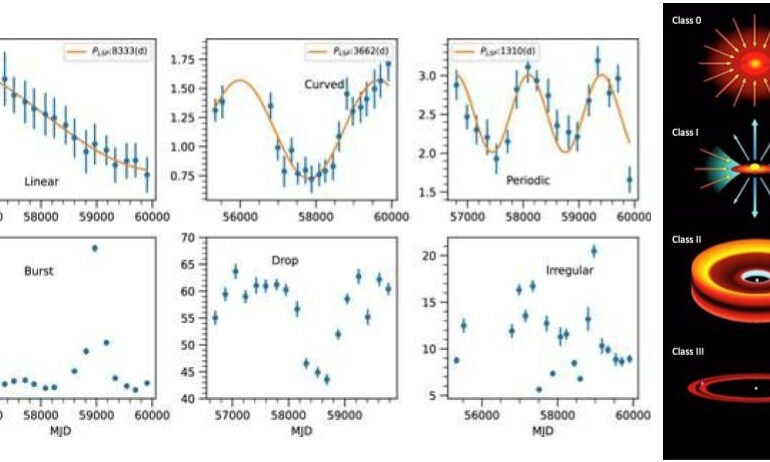NASA’s decade-long infrared survey reveals turbulent early lives of young stars

Schematic representation of the four evolutionary stages of protostars (adapted from Andrea Isella’s 2006 thesis). Class 0 objects are deeply embedded in a dense envelope, with a small central core. In Class I, the core continues to grow, and a flattened circumstellar disk begins to form. By Class II, most of the surrounding material has settled into a prominent disk of gas and dust. In the final Class III stage, the disk has largely dissipated, and the star's spectral energy distribution resembles that of a mature stellar photosphere.
New Delhi, November 27: A decade of observations from NASA’s WISE and NEOWISE missions has unveiled one of the most detailed portraits yet of stellar infancy, revealing that young stars undergo far more chaotic and unpredictable changes than previously understood. The findings come from a sweeping new study published in The Astrophysical Journal Supplement Series, led by Neha Sharma and Saurabh Sharma of the Aryabhatta Research Institute of Observational Sciences (ARIES) under the Department of Science & Technology.
Young stellar objects (YSOs)—stars in their earliest evolutionary stages—were tracked across more than 22,000 light curves gathered over ten years at 3.4 and 4.6 microns. The study catalogs the mid-infrared variability of YSOs across massive star-forming regions in the Milky Way, offering fresh insights into how stars form, accrete material, and evolve through their dust-enshrouded beginnings.
YSOs form when dense molecular clouds collapse due to gravity, often triggered by shocks from supernovae, radiation pressure from nearby stars, or turbulence in the interstellar medium. As the cloud contracts, a protostar forms at the center, surrounded by a rotating disk of gas and dust. The protostar’s light comes not from fusion, but from gravitational collapse and episodic accretion—processes that naturally lead to dramatic fluctuations in brightness.
By classifying the variability into six categories—linear, curved, periodic, burst, drop and irregular—the team found that 26% of YSOs showed clear variability, with irregular patterns being the most common. Younger Class I YSOs were significantly more variable than older Class III stars, underscoring the volatility of early stellar development.
Color trends added another dimension to the findings. While most YSOs became redder when brightening, hinting at increased dust heating or extinction, some grew bluer—a behavior more prevalent among the youngest objects, possibly signaling intense accretion episodes or alterations in inner disk structure.
Lead author Neha Sharma said the catalog provides “one of the most complete mid-infrared views of stellar youth,” enabling astronomers to trace how stars accumulate mass and disperse their birth material. The study includes more than 5,800 variable YSOs and is expected to serve as a key resource for future research.
With next-generation instruments such as the James Webb Space Telescope and India’s 3.6m Devasthal Optical Telescope gearing up for follow-up observations, scientists expect an even clearer picture of how stars like the Sun emerge from their turbulent infancy.








